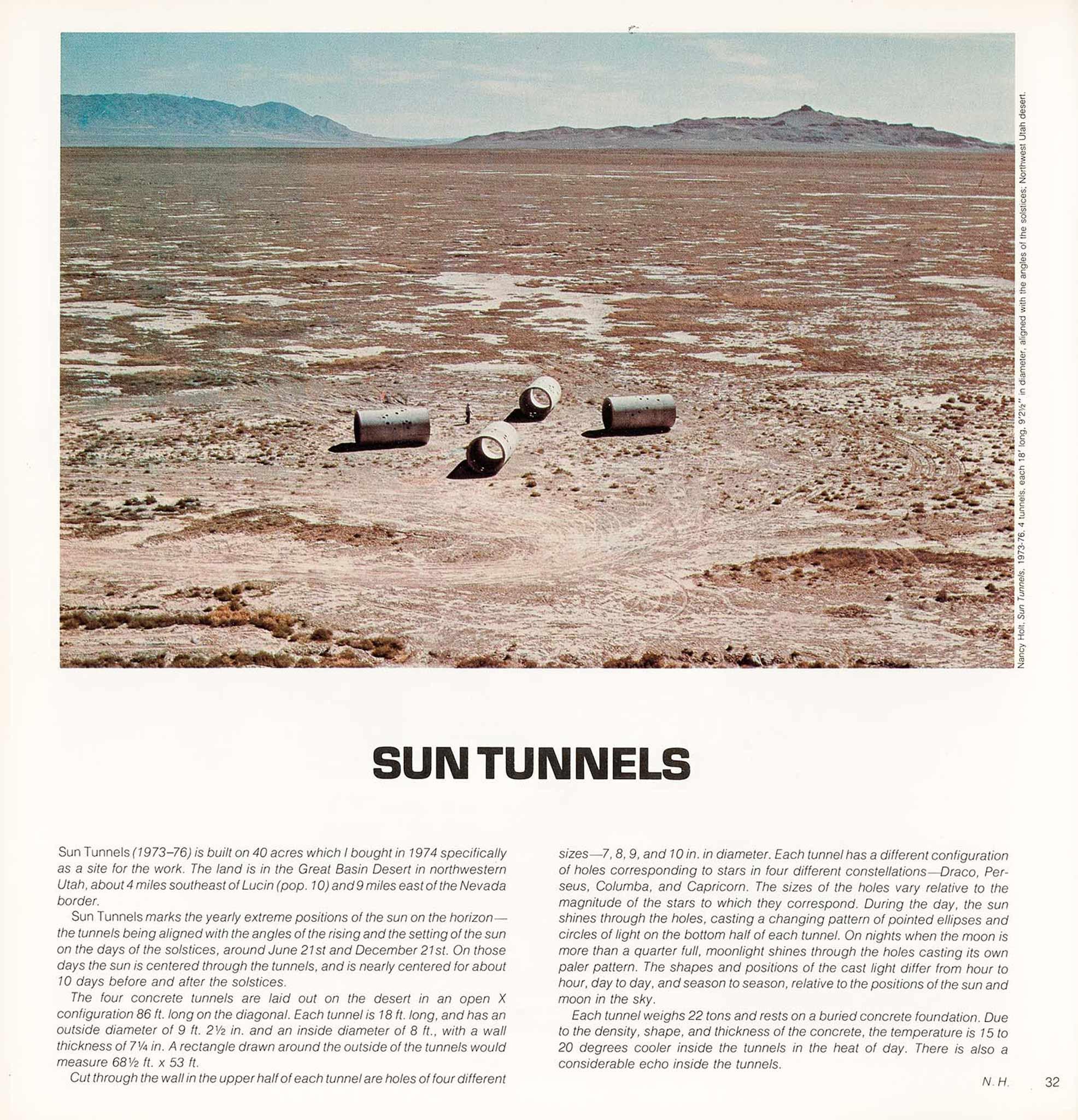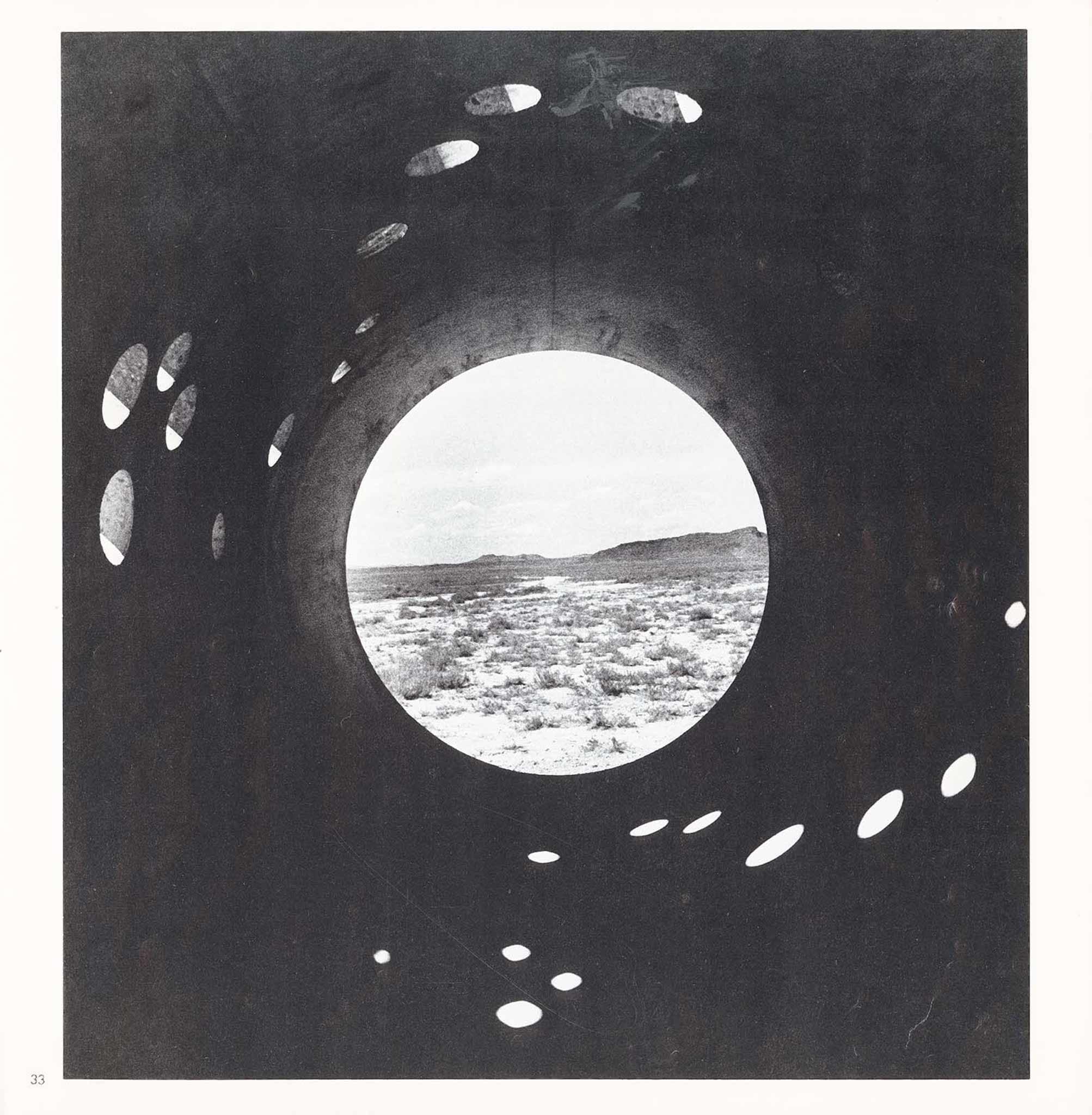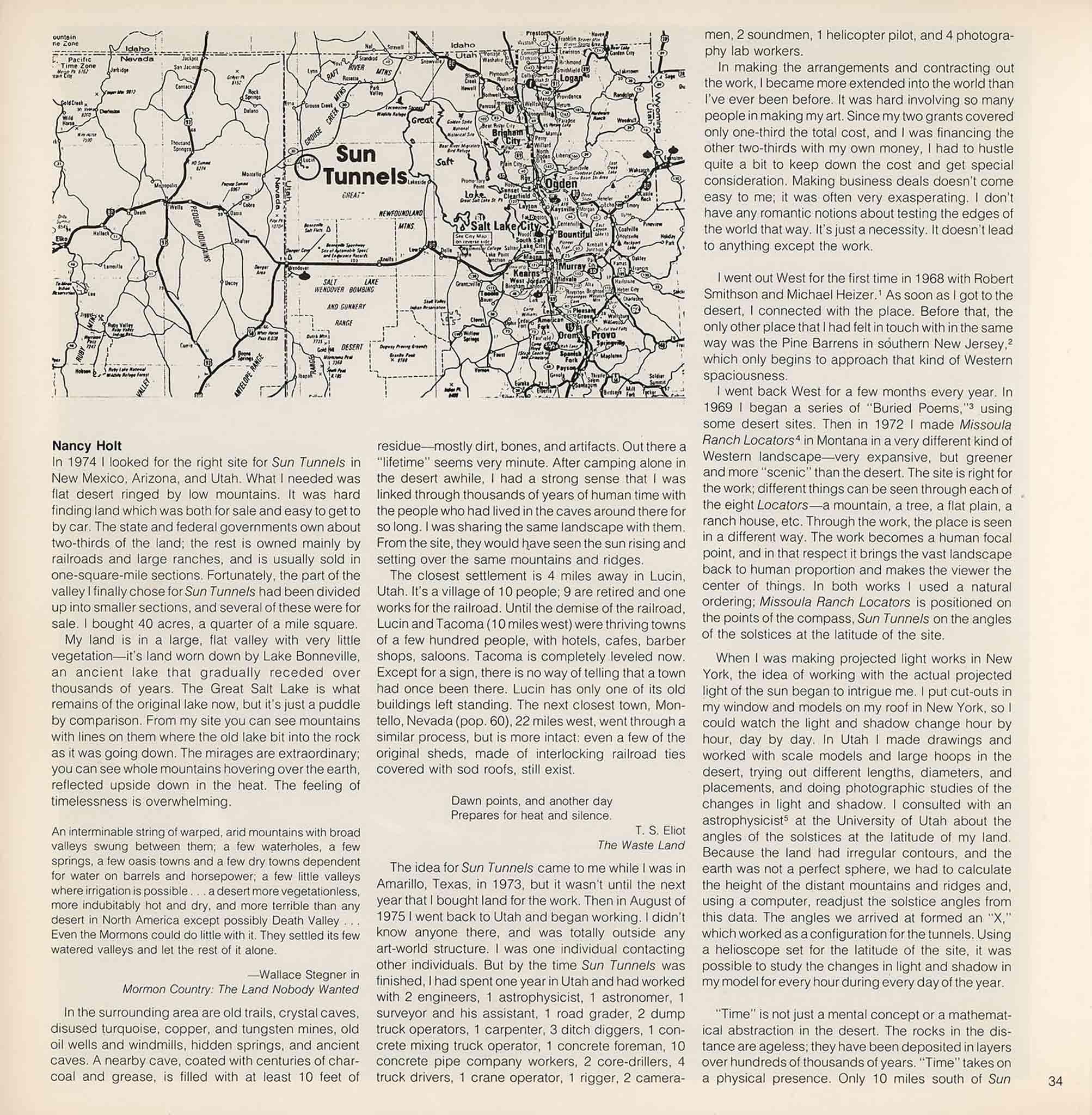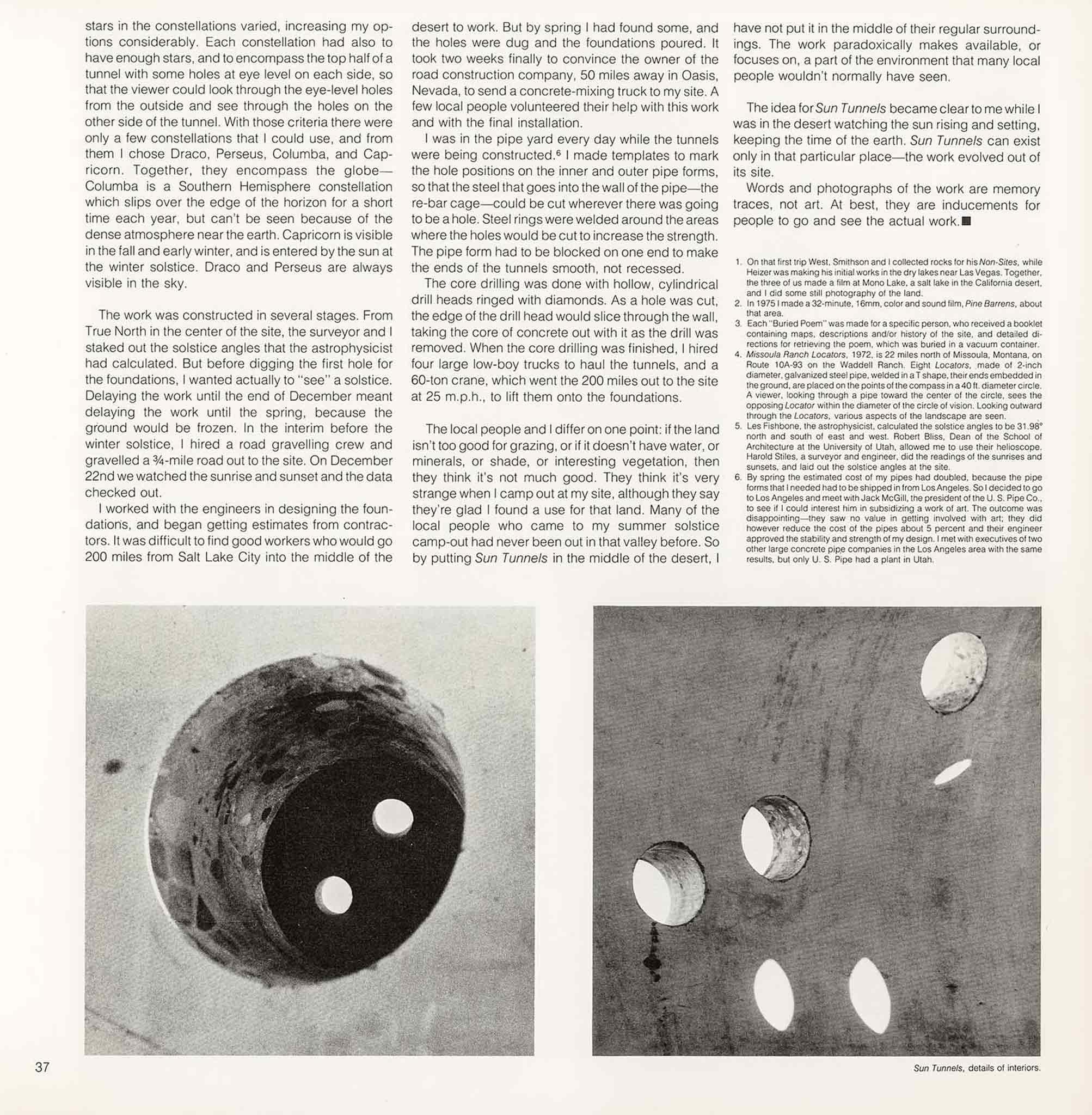Sun Tunnels
Sun Tunnels, 1973–76, is built on forty acres, which I bought in 1974 specifically as a site for the work. The land is in the Great Basin Desert in northwestern Utah, about four miles southeast of Lucin (pop. ten) and nine miles east of the Nevada border.
Sun Tunnels marks the yearly extreme positions of the sun on the horizon—the tunnels being aligned with the angles of the rising and setting of the sun on the days of the solstices, around June 21st and December 21st. On those days the sun is centered through the tunnels, and is nearly center for about ten days before and after the solstices.
The four concrete tunnels are laid out on the desert in an open X configuration eighty-six feet long on the diagonal. Each tunnel is eighteen feet long, and has an outside diameter of nine feet and two-and-a-half inches and an inside diameter of eight feet with a wall of thickness of seven-and-a-quarter inches. A rectangle drawn around the outside of the tunnels would measure sixty-eight-and-a-half feet by fifty-three feet.
Cut through the wall in the upper half of each tunnel are holes of four different sizes—seven, eight, nine, and ten inches in diameter. Each tunnel has a different configuration of holes corresponding to stars in four different constellations—Draco, Perseus, Columba, and Capricorn. The sizes of the holes vary relative to the magnitude of the stars to which they correspond. During the day, the sun shines through the holes, casting a changing pattern of pointed ellipses and circles of light on the bottom half of each tunnel. On nights when the moon is more than a quarter full, moonlight shines through the holes casting its own paler pattern. The shapes and positions of the cast light differ from hour to hour, day to day, and season to season, relative to the positions of the sun and moon in the sky.
Each tunnel weighs twenty-two tons and rests on a buried concrete foundation. Due to the density, shape, and thickness of the concrete, the temperature is fifteen to twenty degrees cooler inside the tunnels in the heat of day. There is also a considerable echo inside the tunnels.
—N.H.
In 1974 I looked for the right site for Sun Tunnels in New Mexico, Arizona, and Utah. What I needed was flat desert ringed by low mountains. It was hard finding land which was both for sale and easy to get to by car. The state and federal governments own about two-thirds of the land, the rest is owned mainly by railroads and large ranches, and is usually sold in one-square-mile sections. Fortunately, the part of the valley I finally chose for Sun Tunnels had been divided up into smaller sections, and several of these were for sale. I bought forty acres, a quarter of a mile square.
My land is in a large, flat valley with very little vegetation—it’s land worn down by Lake Bonneville, an ancient lake that gradually receded over thousands of years. The Great Salt Lake is what remains of the original lake now, but it’s just a puddle by comparison. From my site you can see mountains with lines on them where the old lake bit into the rock as it was going down. The mirages are extraordinary: You can see whole mountains hovering over the earth, reflected upside down in the heat. The feeling of timelessness is overwhelming.
An interminable string of warped, arid mountains with broad valleys swung between them, a few waterholes, a few springs, a few oasis towns and a few dry towns dependent for water on barrels and horsepower, a few little valleys where irrigation is possible...a desert more vegetationless, more indubitably hot and dry, and more terrible than any desert in North America except possibly Death Valley...Even the Mormons could do little with it. They settled its few watered valleys and let the rest of it alone.
—Wallace Stegner in Mormon Country: The Land Nobody Wanted
In the surrounding area are old trails, crystal caves, disused turquoise, copper, and tungsten mines, old oil wells and windmills, hidden springs, and ancient caves. A nearby cave, coated with centuries of charcoal and grease, is filled with at least ten feet of residue—mostly dirt, bones, and artifacts. Out there a “lifetime” seems very minute. After camping alone in the desert awhile, I had a strong sense that I was linked through thousands of years of human time with the people who had lived in the caves around there for so long. I was sharing the same landscape with them. From the site, they would have seen the sun rising and setting over the same mountains and ridges.
The closest settlement is four miles away in Lucin, Utah. It’s a village of ten people; nine are retired and one works for the railroad. Until the demise of the railroad, Lucin and Tacoma (ten miles west) were thriving towns of a few hundred people, with hotels, cafes, barber shops, saloons. Tacoma is completely leveled now. Except for a sign, there is no way of telling that a town had once been there. Lucin has only one of its old buildings left standing. The next closest town, Montello, Nevada (pop. sixty), twenty-two miles west, went through a similar process, but is more intact: even a few of the original sheds, made of interlocking railroad ties covered with sod roofs, still exist.
Dawn points, and another day Prepares for heat and silence.
—T.S. Eliot, The Waste Land
The idea for Sun Tunnels came to me while I was in Amarillo, Texas, in 1973, but it wasn’t until the next year that I bought land for the work. Then in August of 1975 I went back to Utah and began working. I didn’t know anyone there, and was totally outside any art-world structure. I was one individual contacting other individuals. But by the time Sun Tunnels was finished, I had spent one year in Utah and had worked with two engineers, one astrophysicist, one astronomer, one surveyor and his assistant, one road grader, two dump truck operators, one carpenter, three ditch diggers, one concrete mixing truck operator, one concrete foreman, ten concrete pipe company workers, two core-drillers, four truck drivers, one crane operator, one rigger, two cameramen, two soundmen, one helicopter pilot, and four photography lab workers.
In making the arrangements and contracting out the work, I became more extended into the world than I’ve ever been before. It was hard involving so many people in making my art. Since my two grants covered only one-third the total cost, and I was financing the other two-thirds with my own money, I had to hustle quite a bit to keep down the cost and get special consideration. Making business deals doesn’t come easy to me; it was often very exasperating. I don’t have any romantic notions about testing the edges of the world that way. It’s just a necessity. It doesn’t lead to anything except the work.
I went out West for the first time in 1968 with Robert Smithson and Michael Heizer.1 As soon as I got to the desert, I connected with the place. Before that, the only other place that I had felt in touch with in the same way was the Pine Barrens in southern New Jersey,2 which only begins to approach that kind of Western spaciousness.
I went back West for a few months every year. In 1969 I began a series of “Buried Poems,”3 using some desert sites. Then in 1972 I made Missoula Ranch Locators4 in Montana in a very different kind of Western landscape—very expansive, but greener and more “scenic” than the desert. The site is right for the work; different things can be seen through each of the eight Locators—a mountain, a tree, a flat plain, a ranch house, etc. Through the work, the place is seen in a different way. The work becomes a human focal point, and in that respect it brings the vast landscape back to human proportion and makes the viewer the center of things. In both works I used a natural ordering; Missoula Ranch Locators is positioned on the points of the compass, Sun Tunnels on the angles of the solstices at the latitude of the site.
When I was making projected light works in New York, the idea of working with the actual projected light of the sun began to intrigue me. I put cut-outs in my window and models on my roof in New York, so I could watch the light and shadow change hour by hour, day by day. In Utah I made drawings and worked with scale models and large hoops in the desert, trying out different lengths, diameters, and placements, and doing photographic studies of the changes in light and shadow. I consulted with an astrophysicist5 at the University of Utah about the angles of the solstices at the latitude of my land. Because the land had irregular contours, and the earth was not a perfect sphere, we had to calculate the height of the distant mountains and ridges and, using a computer, readjust the solstice angles from this date. The angles we arrived at formed an “X,” which worked as a configuration for the tunnels. Using a helioscope set for the latitude of the site, it was possible to study the changes in light and shadow in my model for every hour during every day of the year.
“Time” is not just a mental concept or a mathematical abstraction in the desert. The rocks in the distance are ageless; they have been deposited in layers over hundreds of thousands of year. “Time” takes on a physical presence. Only ten miles south of Sun Tunnels are the Bonneville Salt Flats, one of the few areas in the world where you can actually see the curvature of the earth. Being part of that kind of landscape, and walking on earth that has surely never been walked on before, evokes a sense of being on this planet, rotating in space, in universal time.
By marking the yearly extreme positions of the sun, Sun Tunnels indicates the “cyclical time” of the solar year. The center of the work becomes the center of the world. The changing pattern of light from our “sun-star” marks the days and hours as it passes through the tunnel’s “star-holes.” The positioning of the work is also based on star-study: the surveyor and I were only able to find True North by taking our bearings on the North Star—Polaris—as it ovals around the North Pole because of the earth’s movement.
I wanted to bring the vast space of the desert back to human scale. I had no desire to make a megalithic monument. The panoramic view of the landscape is too overwhelming to take in without visual reference points. The view blurs out rather than sharpens. Through the tunnels, parts of the landscape are framed and come into focus. I chose the diameter, length, and distance between the tunnels based on the proportions of what could be seen of the sky and land, and how long the sun could be seen rising and setting on the solstices.
In the desert, scale is hard to discern from a distance. Mountains that are five or ten miles away look deceptively close. When the Sun Tunnels is seen from four miles away, it seems very large. Closer in, a mile or so away, the relational balance changes and is hard to read. The work is seen from several angles on the road in; at times two of the tunnels line up exactly head on and seem to disappear. Seen from a side angle, the two tunnels in front can totally overlap and cancel out the ones in the back.
From the center of the work, the tunnels extend the viewer visually into the landscape, opening up the perceived space. But once inside the tunnels, the work encloses—surrounds—and there is a framing of the landscape through the ends of the tunnels and through the holes.
The color and substance of the tunnels is the same as the land that they are a part of, and the inner matter of the concrete—the solidified sand and stone—can be seen on the insides of the holes, where the “core-drill” cut through and exposed it. In that kind of space the work had to have a substantial thickness and weight, which was only possible with concrete. The rims are wide enough to frame the space from long distances, and the weight (twenty-two tons per tunnel) gives the work a feeling of permanence.
Only the sunlight holds things together. Noon is the crucial hour; the desert reveals itself nakedly and cruelly, with meaning but its own existence.
—Edward Abbey, Desert Solitaire
In the glare of the desert sunlight, I want to turn away from the sun, rather than contemplate it. When the sunlight is all around me like that, I only become conscious of it when it is edged by shadow. The sunlight pours in wherever there are holes in the tunnels. Because of the seven- and-a-quarter-inch thickness of the holes, the shape of the light that reaches the bottom of the tunnels is usually a pointed ellipse, but there are times when the sun is directly over a hole and a perfect circle is cast. Day is turned into night, and an inversion of the sky takes place: stars are cast down to Earth, spots of warmth in cool tunnels.
Moonlike crescents of light form inside the rims of the tunnels. They elongate in the early and late hours of the day, and disappear altogether when the tunnels are in full shadow inside, which occurs at a different time on one diagonal of the “X” than it does on the other. (Around the summer solstice this happens about 12:30 and 3:30.) On days when the clouds come and go, there is a dimming, a darkening, and then a brightening of the areas of light.
When the sun beats down the site, the heat waves seem to make the earth dissolve, and the tunnels appear to lose their substance—they float like the mirages in the distance. Around the time of the solstices, when the sun rises and sets through the tunnels, it glows bright orange on the tunnel walls.
When the white-hot sun was sinking To the blue edge of the mountain, The watchers saw the whiteness turn To red along the rim. Saw the redness deepen, til the sun Like a huge bowl filled with fire Red and glowing, seemed to rest upon the world.
—Navajo Indian Poem trans. Eugenia Faunce Wetherill
The sun is nothing out of the ordinary in the universal scheme of things: merely one star among thousands of millions, and not even a particularly large or bright one.
—J.B. Sidgwick, Introducing Astronomy
At night, even a quarter moon can cast a pattern of light. The moonlight shines through the holes in different positions and with a different intensity than the sunlight does. In the moonlight the tunnels seem to glow from within their own substance, the rims of the tunnels forming crescents in the night. As you move through the tunnels, the moon and stars and planets can be lined up and framed through each hole. Looking up through the holes on a bright night is like seeing the circles of light during the day, only inverted.
The moon was formed billions of years ago. But no one is sure just how. Space was full of dust and rocks in those days, and these came together to form the Earth. Perhaps when the Earth was first formed, part of it broke loose and became the Moon.
—Isaac Asimov, The Moon
Thus he conceived his voyaging to be An up and down between two elements, A fluctuating between sun and moon, A sally into gold and crimson forms.
—Wallace Stevens, “The Comedian as the Letter C”
In choosing the constellation for the holes, I wanted only those with stars of several different magnitudes, so that I could have holes of different diameters. Depending on which of the twelve astronomical charts I consulted, the number and positions of the stars in the constellations varied, increasing my options considerably. Each constellation had also to have enough stars, and to encompass the top half of a tunnel with some holes at eye level on each side, so that the viewer could look through the eye-level holes from the outside and see through the holes on the other side of the tunnel. With those criteria there were only a few constellations that I could use, and from them I chose Draco, Perseus, Columba, and Capricorn. Together, they encompass the globe—Columba is a Southern Hemisphere constellation which slips over the edge of the horizon for a short time each year, but can’t be seen because of the dense atmosphere near the earth. Capricorn is visible in the fall and early winter, and is entered by the sun at the winter solstice. Draco and Perseus are always visible in the sky.
The work was constructed in several stages. From True North in the center of the site, the surveyor and I staked out the solstice angles that the astrophysicist had calculated. But before digging the first hole for the foundations, I wanted actually to “see” a solstice. Delaying the work until the end of December meant delaying the work until the spring, because the ground would be frozen. In the interim before the winter solstice, I hired a road gravelling crew and graveled a three-quarter-mile road out to the site. On December 22nd we watched the sunrise and sunset and the data checked out.
I worked with the engineers in designing the foundations, and began getting estimates from contractors. It was difficult to find good workers who would go two hundred miles from Salt Lake City into the middle of the desert to work. But by spring I had found some, and the holes were dug and the foundations poured. It took two weeks finally to convince the owner of the road construction company, fifty miles away in Oasis, Nevada, to send a concrete-mixing truck to my site. A few local people volunteered their help with this work and with the final installation.
I was in the pipe yard every day while the tunnels were being constructed.6 I made templates to mark the hole positions on the inner and outer pipe forms, so that the steel that goes into the wall of the pipe—the re-bar cage—could be cut wherever there was going to be a hole. Steel rings were welded around the areas where the holes would be cut to increase the strength. The pipe form had to be blocked on one end to make the ends of the tunnels smooth, not recessed.
The core drilling was done with hollow, cylindrical drill heads ringed with diamonds. As a hole was cut, the edge of the drill head would slice through the wall, taking the core of concrete out with it as the drill was removed. When the core drilling was finished, I hired four large low-boy trucks to haul the tunnels, and a sixty-ton crane, which went the two hundred miles out to the site at twenty-five m.p.h., to lift them onto the foundations.
The local people and I differ on one point: if the land isn’t too good for grazing, or if it doesn’t have water, or minerals, or shade, or interesting vegetation, then they think it’s not much good. They think it’s very strange when I camp out at my site, although they say they’re glad I found a use for that land. Many of the local people who came to my summer solstice camp-out had never been out in that valley before. So by putting Sun Tunnels in the middle of the desert, I have not put it in the middle of their regular surroundings. The work paradoxically makes available, or focuses on, a part of the environment that many local people wouldn’t normally have seen.
The idea for Sun Tunnels became clearer to me while I was in the desert watching the sun rising and setting, keeping the time of the earth. Sun Tunnels can exist only in that particular place—the work evolved out of its site.
Words and photographs of the work are memory traces, not art. At best, they are inducements for people to go and see the actual work.
- 1On that first trip West, Smithson and I collected rocks for his Non-Sites, while Heizer was making his initial works in the dry lake near Las Vegas. Together, the three of us made a film at Mono Lake, a salt lake in the California desert, and I did some still photography of the land.
- 2In 1975 I made a thirty-two-minute, 16mm, color and sound film, Pine Barrens, about that area.
- 3Each “Buried Poem” was made for a specific person, who received a booklet containing maps, descriptions and/or history of the site, and detailed directions for retrieving the poem, which was buried in a vacuum container.
- 4Missoula Ranch Locators, 1972, is twenty-two miles north of Missoula, Montana, on Route 10A-93 on the Waddell Ranch. Eight Locators, made of two-inch diameter, galvanized steel pipe, welded in a T shape, their ends embedded in the ground, are placed on the points of the compass in a forty-foot diameter circle. A viewer, looking through a pipe toward the center of the circle, sees the opposing Locator within the diameter of the circle of vision. Looking outward through the Locators, various aspects of the landscape are seen.
- 5Les Fishbone, the astrophysicist, calculated the solstice angles to be 31.98° north and south of east and west. Robert Bliss, Dean of the School of Architecture at the University of Utah, allowed me to use their helioscope. Harold Stiles, a surveyor and engineer, did the readings of the sunrises and sunsets, and laid out the solstice angles at the site.
- 6By spring the estimated cost of my pipes had doubled, because the pipe forms that I needed had to be shipped in from Los Angeles. So I decided to go to Los Angeles and meet with Jack McGill, the president of the U.S. Pipe Co., to see if I could interest him in subsidizing a work of art. The outcome was disappointing—they saw no value in getting involved with art; they did however reduce the cost of the pipes about five percent and their engineer approved the stability and strength of my design. I met with executives of two other large concrete pipe companies in the Los Angeles area with the same results, but only U.S. Pipe had a plant in Utah.
Holt, Nancy. "Sun Tunnels." Artforum Vol.15, No.8 (April, 1977).






